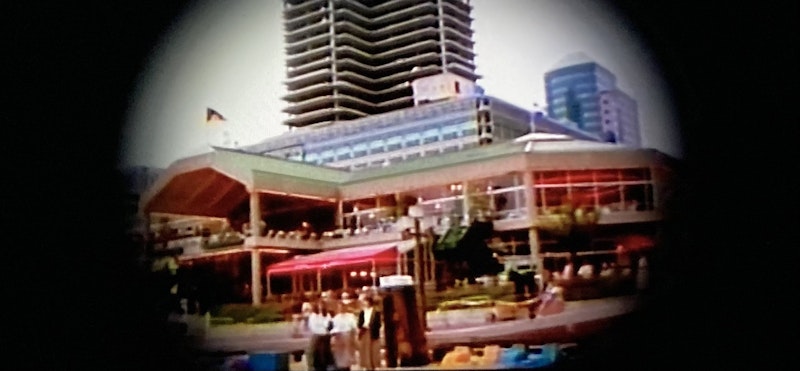It’s not often that I’m taken aback by local news, but last week, after reading an article in The Baltimore Brew about the ongoing negligence of the Inner Harbor’s Harborplace, I did a double-take. The delapidated onetime massive tourist attraction pops up in Baltimore news outlets several times a year, mostly about random crime there and questions about what to do with the two pavilions that are now mostly barren. Mayor Brandon Scott is a do-nothing executive, but his acquiescence to Harborplace’s current owner, MCB Real Estate, was discouraging even by his low standards.
Scott and other city officials gave MCB three years “to figure out a plan” for what to do with the structure. In addition, according to the Brew, “Among the other terms of the amended lease that the Board of Estimates approved were three years of rent abatement and up to $1 million for future planning and other costs.” I’ll speculate that there’s a mess of graft going on here—nothing new in this city, which hasn’t had a dynamic mayor since William Donald Schaefer, who was a bombastic showboat, but unabashedly loved the city he grew up in, and though he had plenty of political cronies (Irv Kovens, most notably) there was never an accusation that he illegally pocketed a dime—but this deal busts the “outrageous” scale.
Why does MCB need three years to “devise a turnaround strategy”? In a city that’s desperately in need of a downtown revival—the decreased population, unlike the 1960s, isn’t just “white flight” but anyone who’s fed up with the crime, taxes and streets (excluding the generic Harbor East) that are populated by chain franchises, dollar stores and nail salons—giving the owner of prime real estate the time and money to execute a transformation is governmental malfeasance. It doesn’t require much imagination to envision the state of the Light and Pratt St. pavilions, left vacant, three years from now.
Some history: when James Rouse, the “urban pioneer” who created Maryland’s planned town Columbia (1967), and renovated Boston’s Faneuil Hall (1976), and his company proposed the idea of Harborplace, it was met with a mixed reception. Schaefer was gung-ho; a lot of residents decried “commercialism” and the disappearance of the “open space” at the rotting Inner Harbor at the time. A referendum was put to voters in November, 1978, and passed. Ground was broken just two months later, and on July 2, 1980, Harborplace was opened, to immediate fanfare. That was less than two years, vote-to-fruition, compared to the three years given an owner to “come up with a plan.” Soon the National Aquarium (1981) opened, furthering an already-bustling tourism and people returning to the city to live and work, as well as the sprucing up of various neighborhoods.
(In this segregated city, much to the shame of every elected official since the Martin Luther King riots of 1968, mostly-black neighborhoods are still scarred by boarded-up rowhouses and a lack of shopping alternatives.)
In 1992, the Baltimore Orioles moved to the new Camden Yards park not far from the Inner Harbor (not that it matters much, but I’ve mixed feelings about that addition: taxpayers were forced to subsidize the stadium, and it ruined the Waverly neighborhood in North Baltimore where the Orioles and Colts played at Memorial Stadium), the Gallery mall/hotel was opened across from Harborplace, and downtown was busy.
As editor and co-owner of City Paper at the time of the Harborplace debate in ’78, I supported the idea, and the paper editorialized in favor of it, distressing many readers who thought the paper was selling out to The Man. In a way, yes: my partner Alan Hirsch and I envisioned (or at least hoped for) more advertising for our still-struggling weekly, but also, as city residents who remembered a deserted downtown after 7 p.m. just a few years earlier, we wanted a more exciting place to live, whether that meant more restaurants, retail locations and simply, more to do.
As Jacques Kelly wrote in a retrospective May, 2022 Baltimore Sun column, the bounty of Harborplace when it opened surprised even its vocal opponents. Kelly: “Guests were surprised by Tulkoff’s Some Like It Hot Horseradish stand, Ostrowski’s homemade Polish kielbasa and Ms. Desserts… You could spend $3 on a bag of salted nuts. Some of the retail sellers had large shops; others were colorful push carts. You could buy wallpaper, tripe, dollhouse furniture and uncooked scallops.”
Scores of restaurants too: Phillips Seafood, Tandoor, City Lights, Taverna Athena (my favorite), Jean-Claude’s and the American Café, to name just a few. Thrasher’s French Fries always had a long line, as did a pizza joint, the name of which escapes me. And Harborplace News was a place to browse, back when there was still a vast array of newspapers and magazines on offer.
Brandon Scott and MCP real estate aren’t interested in my opinion, but here’s a plan that won’t take three years: convert the pavilions into moderately high-rise condos—best view in the city, aside from atop Federal Hill—with an adjacent parking garage. The first floor of each pavilion could house, say, a seafood market, restaurants, gym or Pilates outlet, a fancy sweets shop, and a sprawling produce section. I’m certain there would be scads of paperwork and waivers of zoning laws, but since it’s apparent no one’s working on any plan at all, I’d say time could be made.
—Follow Russ Smith on Twitter: @MUGGER2023

